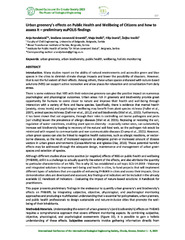| dc.description.abstract | Many studies report on the ability of natural environments and accessible green and blue
spaces in the cities to diminish climate change impacts and lower the possibility of disasters. However,
that is not the full extent of their effects. Among others, these urban spaces enhanced with nature-based
solutions (NBS) can support active recreation and allow places for relaxation and consolidation from daily
stress.
There is some evidence that NBS with their extensive greenery can give the positive impact on numerous
psychological and physiological outcomes. Urban areas rich in greenery and biodiversity provide great
opportunity for humans to come closer to nature and improve their health and well-being through
interaction with a variety of flora and fauna species. Specifically, there is evidence that mental health
(anxiety, stress levels) and psychological wellbeing may benefit from plant species richness (Fuller et al.,
2007), animal species richness (Dallimer et al., 2012) and soil biodiversity (Wall et al., 2015). Furthermore,
it has been shown that soil organisms, through their roles in controlling soil-borne pathogens and pests
(soil vitality) lessen the prevalence of allergic diseases (Wall et al. 2015). Replacing or restoring the soil,
regulation of water conditions, enabling plant species diversity - especially native ones, can substantially
increase soil biodiversity leading to recovery of the natural soil food web, so the pathogen risk would be
minimized with respect to communicable and non-communicable diseases (Crump et al., 2021). However,
urban green spaces can also be linked to negative health outcomes, such as allergic reactions, or vectorborne diseases, as the result of increased exposure to allergenic pollen or increased amount of disease
vectors in urban green environments (Calaza‐Martinez and Iglesias‐Díaz, 2016). These potential harmful
effects may be addressed through the adequate design, maintenance and management of urban green
spaces and selection of species.
Although different studies show some positive (or negative) effects of NBS on public health and wellbeing
(PH&WB), still it is a challenge to actually quantify the extent of the effects, and also attribute the quantity
to particular characteristics of an NBS. This is why EC has established a call topic SC5-14-2019 - Visionary
and integrated solutions to improve well-being and health in cities, to fund projects that will implement
different types of solutions that are capable of enhancing PH&WB in cities and assess their impacts. Once
demonstration sites are developed and assessed, key findings and indicators will be included in the already
available EC Handbook of indicators - Evaluating the impact of nature-based solutions: A handbook for
practitioners.
This paper presents preliminary findings in the endeavour to quantify urban greenery’s and biodiversity’s
effects on PH&WB, by integrating subjective, objective, physiological, and psychological monitoring
approaches and producing a multifaceted understanding that is essential for policymakers, urban planners,
and public health professionals to design sustainable and nature-inclusive cities that promote the wellbeing of their inhabitants. | sr |

